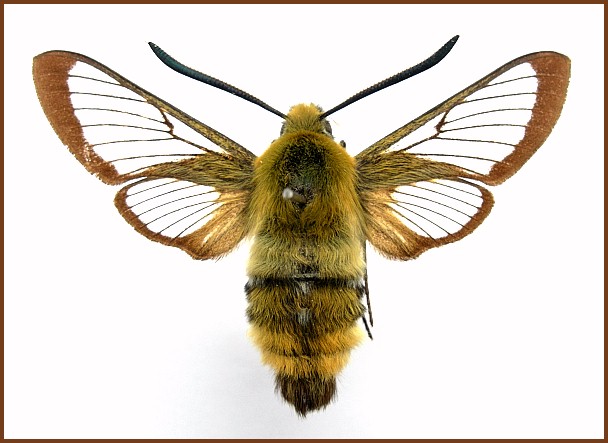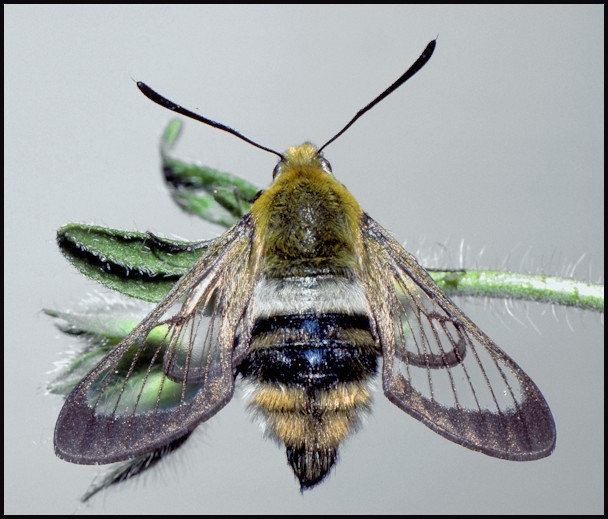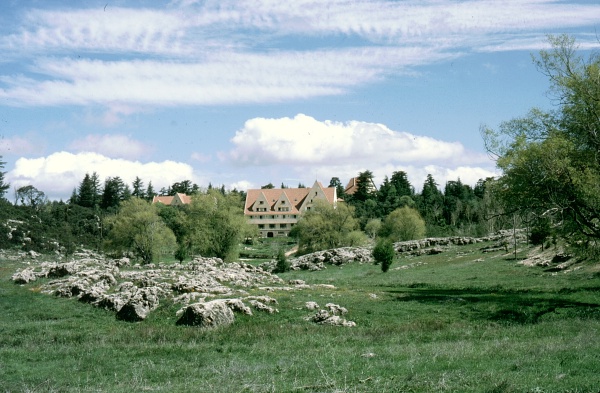UK: Atlas Bee Hawkmoth, F: Sphinx des abeilles de l'Atlas
Haemorrhagia tityus aksana Le Cerf, 1923, Bull. Soc. ent. Fr.: 199.Type locality: Azrou, Middle Atlas, Morocco.
(Taxonomic notes. (i) Eitschberger et al. (1989) raised subsp. aksana to specific rank but gave no valid reasons for doing so; however, recent studies indicate that aksana is indeed a good species, with genitalia different from Hemaris tityus (Linnaeus, 1758). In the male genitalia, the left harpe is represented by a distinct triangular, spinose lobe. The right harpe is more slender and curved ventrally, with an unexpanded apex. Female genitalia similar to Hemaris tityus, but antrum almost as broad as the eighth abdominal segment. Ductus bursae extremely short and broad, giving the appearance that the antrum and corpus bursae are directly joined.
(ii) Recent DNA barcoding studies indicate that Hemaris galunae (Eitschberger, Müller & Kravchenko, 2005) from the Levant is related to this species. The two species, which are related to Hemaris tityus, appear to be the western and eastern remnants of a species which once occurred right across a cooler, greener and wetter North Africa during the last ice age.)
Holarctic; western Palaearctic region. Pleistocene refuge: Monocentric -- Atlantomediterranean and Mauritanian subsections of the Mediterranean refuge. Part of the present-day relict Mauritanian faunal element centred on the Middle and High Atlas Mountains (see de Lattin, 1967).

Wingspan: 44--51mm. Similar to Hemaris tityus, but the green of the thorax is less yellowish. Grey basal area of the forewing extended and marginal band blackish and broader than in Hemaris tityus.

Diurnal. A species of flower-rich meadows between 1300 and 2500m.
This species is active during the day, generally between 10.00 and 15.00 hours, when it can be seen flitting rapidly from flower to flower. Although mimicking a bumble bee in coloration, its flight is much more rapid and agile. Its skill is superbly demonstrated during courtship when pairs chase each other low over the ground as well as spiralling upwards like a whirlwind. Copulation generally follows, with pairs remaining in copula for up to two hours.

In its warmest locations, on the wing in March, June and August; at higher altitude, the latter half of May or June as a single brood, sometimes with a partial second brood in August (Rungs, 1981).
OVUM: Small (1.1 x 1.0mm), almost spherical, with a small depression on top; pale glossy green. Laid singly on the underside of a leaf of the hostplant, with up to six per plant or group of plants not uncommon.
LARVA: Full-fed 50mm.
The newly-hatched, white larva is about 3mm long and covered with small black tubercles bearing forked, black hairs. The caudal horn is small with two black hairs at its apex. With each moult and feeding the body and tubercles gradually become green, the horn redder, and pale dorso-lateral and ventro-lateral lines appear along the side. Fully grown, most are whitish green with a dull red horn, purple-red ventral surface and with purple-red surrounds to the spiracles. The body is very rough to the touch. Many are heavily spotted with additional reddish blotches, especially those feeding on purple-spotted scabious leaves. When fully grown, such blotches are masked as the larva turns a rich plum colour prior to pupation.
Throughout its life, the larva generally remains beneath a leaf, nibbling holes on either side of the midrib on which it rests. Most active at night; if disturbed during the day, it will drop to the ground, many even taking shelter there when not feeding. A noteworthy feature of this species is the variation in growth-rate of larvae of the same brood; however, all tend to mature much more rapidly than those of other sphingids.
Hostplants. Scabiosa spp.
PUPA: 24--27mm. Typically Hemaris in shape, but blackish brown, tinted with reddish brown at the juncture of each segment. Body tapers at either end, with two sharp head tubercles and a flat triangular cremaster. Formed in a rather strong but coarse cocoon among grass tussocks, or slightly into the soil. The overwintering stage.
None recorded.
Known from the Middle and High Atlas Mountains of Morocco (Rungs, 1981), but may be more widespread in these mountains. Ifrane is a well known locality (Prins, Kok & Turelinckx, 1984), as is Azrou (Le Cerf, 1923). There is also a single 2024 photographic record from Algeria (Hamid Mezaguer, pers. comm. 2024).
Extra-limital range. None.
None.
 Return to species list
Return to species list